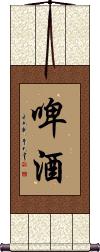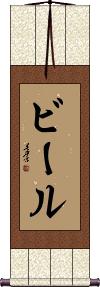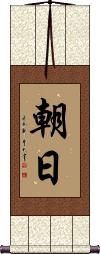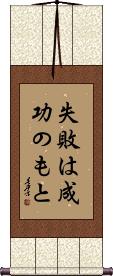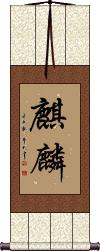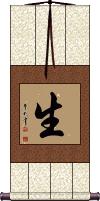Many custom options...
And formats...

Beer in Chinese / Japanese...
Buy a Beer calligraphy wall scroll here!
Personalize your custom “Beer” project by clicking the button next to your favorite “Beer” title below...
1. Beer
3. Failure is a Stepping Stone to Success
4. Kirin / Giraffe / Mythical Creature
5. Birth / Life
Beer
啤酒 means beer in Chinese.
This can refer to virtually any fermented grain-based alcoholic beverage that has bubbles. So this includes all kinds of ales and lagers.
In China, the grains used for beer sometimes include rice. But even in Chinese beer, the concept is the same - beer must be made with hops and yeast.
Beer was the third word I learned in Chinese, and I've toured 3 different breweries in China, Tsing Tao, Lao Shan, and Yanjing. I've done my research on this calligraphy entry!
Beer
Asahi / Morning Sun
朝日 is a version of the Japanese name Asahi.
This can also be Ahisa, Asuka, Ashita, or Asaka. This means morning sun and is the name of the famous beer company in Japan.
This would be read as “Zhao Ri” in Mandarin where it means morning sun but is also known to be the Asahi company (maker of beer and other beverages).
Failure is a Stepping Stone to Success
This Japanese proverb literally reads, “failures/mistakes/blunders are the yeast-starter/yeast-mash of success.”
Basically, it suggests that failures are a necessary part of success; Just as bread or beer requires yeast to successfully rise or brew/ferment.
Note: Because this selection contains some special Japanese Hiragana characters, it should be written by a Japanese calligrapher.
Kirin / Giraffe / Mythical Creature
麒麟 is the title of a mythical beast of Asia.
The animal is thought to be related to the giraffe, and in some ways, it is a giraffe. However, it is often depicted with the horns of a dragon or deer and sometimes with the body like a horse, but many variations exist.
In Japanese, it is pronounced “Kirin” as in “Kirin Ichiban” beer.
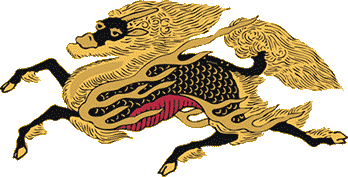
Notes:
1. This is sometimes spelled as “kylin.”
2. In Japanese, this is the only Kanji word for giraffe. Therefore in Japan, this word needs context to know whether you are talking about the mythical creature or the long-necked giraffe of Africa.
3. Apparently, this was the first word used for regular giraffes in China (some were brought from Africa to China during the Ming Dynasty - probably around the year 1400). Though the mythical creature may have existed before, the name “qilin” was given to the “new giraffe.” This is because, more than 600 years ago, giraffes somewhat matched the mythical creature's description when Chinese people saw them for the first time. Later, to avoid such an ambiguous title, a three-character word was devised to mean a “giraffe of Africa.” The characters for “qilin” shown here are only for the mythological version in modern Chinese.
4. More information about the qilin / kirin from Wikipedia.
5. This creature is sometimes translated as the “Chinese Unicorn,” although it is generally portrayed with two horns. I think this is done more for the fantasy aspect of the unicorn and because most westerners don't know what a qilin or kirin is (this avoids a long explanation by the translator).
6. In Korean, this can mean kirin or simply giraffe (usually, the mythological creature is what they would think of when seeing these characters alone on a wall scroll).
Birth / Life
生 is a Chinese word that means “to be born” and “to give birth.”
Also, it's often used to refer to life itself, and sometimes “to grow.”
生 is used in a lot of compound words such as “yi sheng,” which means “doctor” (literally “healer of life”), “sheng ri” which means “birthday” (literally “birth-day”), and “xue sheng” which means student (literally “studying life” or “learner [about] life”). Few Chinese people will think of the literal meaning when this uses words like doctor and student - but it is interesting to note.
生 has the same root meaning in Korean Hanja and Japanese. However, in Japanese, there are many possible pronunciations, and this can be used to mean “raw” or “unprocessed” (as in draft beer). Therefore, not be the best if your audience is Japanese.
See Also: Vitality
Mountain Travels Poem by Dumu
This poem was written almost 1200 years ago during the Tang dynasty.
It depicts traveling up a place known as Cold Mountain, where some hearty people have built their homes. The traveler is overwhelmed by the beauty of the turning leaves of the maple forest that surrounds him just as night overtakes the day, and darkness prevails. His heart implores him to stop, and take in all of the beauty around him.
First, before you get to the full translation, I must tell you that Chinese poetry is a lot different than what we have in the west. Chinese words simply don't rhyme in the same way that English or other western languages do. Chinese poetry depends on rhythm and a certain beat of repeated numbers of characters.
I have done my best to translate this poem keeping a certain feel of the original poet. But some of the original beauty of the poem in its original Chinese will be lost in translation.
Far away on Cold Mountain, a stone path leads upwards.
Among white clouds, people's homes reside.
Stopping my carriage I must, as to admire the maple forest at nights fall.
In awe of autumn leaves showing more red than even flowers of early spring.
Hopefully, this poem will remind you to stop, and “take it all in” as you travel through life.
The poet's name is “Du Mu” in Chinese that is: ![]()
![]() .
.
The title of the poem, “Mountain Travels” is: ![]()
![]()
You can have the title, poet's name, and even “Tang Dynasty” written as an inscription on your custom wall scroll if you like.
More about the poet:
Dumu lived from 803-852 AD and was a leading Chinese poet during the later part of the Tang dynasty.
He was born in Chang'an, a city in central China and the former capital of the ancient Chinese empire in 221-206 BC. In present-day China, his birthplace is currently known as Xi'an, the home of the Terracotta Soldiers.
He was awarded his Jinshi degree (an exam administered by the emperor's court which leads to becoming an official of the court) at the age of 25 and went on to hold many official positions over the years. However, he never achieved a high rank, apparently because of some disputes between various factions, and his family's criticism of the government. His last post in the court was his appointment to the office of Secretariat Drafter.
During his life, he wrote scores of narrative poems, as well as a commentary on the Art of War and many letters of advice to high officials.
His poems were often very realistic and often depicted everyday life. He wrote poems about everything, from drinking beer in a tavern to weepy poems about lost love.
The thing that strikes you most is the fact even after 1200 years, not much has changed about the beauty of nature, toils, and troubles of love and beer drinking.
Not the results for Beer that you were looking for?
Below are some entries from our dictionary that may match your Beer search...
| Characters If shown, 2nd row is Simp. Chinese |
Pronunciation Romanization |
Simple Dictionary Definition |
泡 see styles |
pào pao4 p`ao pao hō あわ |
More info & calligraphy: Paoabubble; foam; froth; head on beer A bubble, a blister; to infuse. |
啤酒 see styles |
pí jiǔ pi2 jiu3 p`i chiu pi chiu |
More info & calligraphy: Beer |
波特 see styles |
bō tè bo1 te4 po t`e po te |
More info & calligraphy: Porter |
麒麟 see styles |
qí lín qi2 lin2 ch`i lin chi lin kirin きりん |
More info & calligraphy: Kirin / Giraffe / Mythical Creature(1) (kana only) giraffe (Giraffa camelopardalis); (2) qilin (Chinese unicorn); (3) Kirin (brand of beer); (surname, female given name) Kirin Male and female unicorns; the qilin in general. |
啤 see styles |
pí pi2 p`i pi |
beer |
沫 see styles |
mò mo4 mo matsu あわ |
foam; suds bubble; foam; froth; head on beer foam |
ビヤ see styles |
piya ピヤ |
beer (dut: bier, eng:); (place-name) Piya |
世濤 世涛 see styles |
shì tāo shi4 tao1 shih t`ao shih tao |
stout (beer) (loanword) |
中瓶 see styles |
chuubin / chubin ちゅうびん |
medium-sized bottle (of beer) |
力波 see styles |
lì bō li4 bo1 li po |
Reeb, a beer brand |
扎啤 see styles |
zhā pí zha1 pi2 cha p`i cha pi |
draft beer |
散裝 散装 see styles |
sǎn zhuāng san3 zhuang1 san chuang |
loose goods; goods sold open; draft (of beer, as opposed to bottled) |
果啤 see styles |
guǒ pí guo3 pi2 kuo p`i kuo pi |
fruit beer |
段腹 see styles |
danbara だんばら |
(See 三段腹) potbelly; beer belly |
淡啤 see styles |
dàn pí dan4 pi2 tan p`i tan pi |
light beer |
爆弾 see styles |
bakudan(p); bakudan ばくだん(P); バクダン |
(1) bomb; (2) (kana only) alcohol with liquor added (esp. wine-based shōchū highball, also beer with whiskey) |
生中 see styles |
namachuu / namachu なまちゅう |
(See 生・なま・7,中ジョッキ) medium-size draft beer; (surname) Ikunaka |
生啤 see styles |
shēng pí sheng1 pi2 sheng p`i sheng pi |
draft beer; unpasteurized beer |
百威 see styles |
bǎi wēi bai3 wei1 pai wei |
Budweiser (beer) |
虎牌 see styles |
hǔ pái hu3 pai2 hu p`ai hu pai |
Tiger Brand (beer) |
釀製 酿制 see styles |
niàng zhì niang4 zhi4 niang chih |
to brew (beer, soy sauce etc); to make (wine, vinegar etc); to distill (spirits) |
釀酒 酿酒 see styles |
niàng jiǔ niang4 jiu3 niang chiu |
to make a fermented drink (i.e. to brew beer, make wine etc) |
金威 see styles |
jīn wēi jin1 wei1 chin wei |
Kingway (Chinese beer brand) |
雑酒 see styles |
zasshu ざっしゅ |
miscellaneous liquors (alcohol tax category); alcohol other than sake, shōchū, mirin, beer, etc. |
麥酒 麦酒 see styles |
mài jiǔ mai4 jiu3 mai chiu |
beer; ale; (archaic) alcoholic drink made from fermented wheat or barley See: 麦酒 |
麦汁 see styles |
bakujuu / bakuju ばくじゅう |
wort (beer before yeast is added); sweet wort |
麦酒 see styles |
bakushu; biiru(gikun) / bakushu; biru(gikun) ばくしゅ; ビール(gikun) |
(See ビール) beer |
ドビア see styles |
dobia ドビア |
(surname) De Beer |
ビーア see styles |
biia / bia ビーア |
beer (dut: bier, eng:) |
ビター see styles |
bitaa / bita ビター |
(noun or adjectival noun) (1) bitter (taste); (2) bitter (type of beer); (personal name) Bidder; Vidor |
Click here for more Beer results from our dictionary
The following table may be helpful for those studying Chinese or Japanese...
| Title | Characters | Romaji (Romanized Japanese) | Various forms of Romanized Chinese | |
| Beer | 啤酒 | pí jiǔ / pi2 jiu3 / pi jiu / pijiu | p`i chiu / pichiu / pi chiu | |
| Beer | ビール | biiru / biru | ||
| Asahi Morning Sun | 朝日 | asahi | zhāo rì zhao1 ri4 zhao ri zhaori | chao |
| Failure is a Stepping Stone to Success | 失敗は成功のもと | sittpai wa seikou no moto sittpaiwaseikounomoto sittpai wa seiko no moto | ||
| Kirin Giraffe Mythical Creature | 麒麟 | kirin | qí lǐn / qi2 lin3 / qi lin / qilin | ch`i lin / chilin / chi lin |
| Birth Life | 生 | shou / iku / sho / iku | shēng / sheng1 / sheng | |
| Mountain Travels Poem by Dumu | 遠上寒山石徑斜白雲生處有人家停車坐愛楓林晚霜葉紅於二月花 远上寒山石径斜白云生处有人家停车坐爱枫林晚霜叶红于二月花 | yuǎn shàng hán shān shí jìng xiá bái yún shēng chù yǒu rén jiā tíng chē zuò ài fēng lín wǎn shuàng yè hóng yú èr yuè huā yuan3 shang4 han2 shan1 shi2 jing4 xia2 bai2 yun2 sheng1 chu4 you3 ren2 jia1 ting2 che1 zuo4 ai4 feng1 lin2 wan3 shuang4 ye4 hong2 yu2 er4 yue4 hua1 yuan shang han shan shi jing xia bai yun sheng chu you ren jia ting che zuo ai feng lin wan shuang ye hong yu er yue hua | yüan shang han shan shih ching hsia pai yün sheng ch`u yu jen chia t`ing ch`e tso ai feng lin wan shuang yeh hung yü erh yüeh hua yüan shang han shan shih ching hsia pai yün sheng chu yu jen chia ting che tso ai feng lin wan shuang yeh hung yü erh yüeh hua |
|
| In some entries above you will see that characters have different versions above and below a line. In these cases, the characters above the line are Traditional Chinese, while the ones below are Simplified Chinese. | ||||
Successful Chinese Character and Japanese Kanji calligraphy searches within the last few hours...
